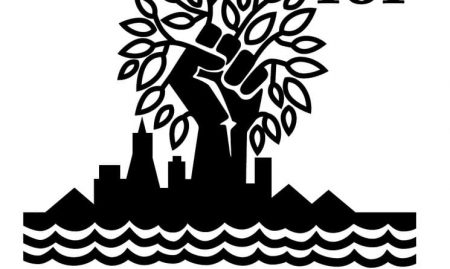-Rachel Siegel, PJC Executive Director
Because there have been so many powerful, global climate justice actions1 recently, we have been asked at the Peace & Justice Center on more than a few occasions if environmental justice is part of our mission. My answer has usually been that we support the amazing work that other groups (350VT in particular) are already doing locally. Rather than reproduce what is already being done, it makes more sense for us to focus on the social justice and anti-militarism issues that feed and are fed by climate disruption.
I still hold this to be true. But more than ever I see that these things are not separate. They don’t just intersect like threads in a web, but they are interwoven — they are of one cloth. I recently had a wonderful conversation with Ruah Swennerfelt, former Board member and local activist, and came to see that we are not framing this connection clearly.
The areas we focus on (racial justice, fair trade, and nonviolence/anti-war) are not separate from ecological justice.2 The climate emergency is a reflection of racial capitalism3 — the human made economic power system that we live under. It’s a system that depends on endless growth at the expense of not just individual human laborers and irreplaceable, unsustainable resource extraction, but of life on this planet for many species including our own.
We see the Amazon burning to make way for corporate agro-business which is decimating small scale farming. This means indigenous people and other people of color, who own these small farms, are most impacted. Racism allows this ecological disaster and the ecological disaster expands racism. If people in power cared about these POC-run farms,4 they couldn’t callously put them out of business for their own profits. Once these farms shut down, the farmers become labor refugees, climate refugees, or just desolate. So you see, our racial justice and fair trade work are climate justice work. It is soil justice, water justice, and Indigenous Justice (which doesn’t usually separate human from nature). It is not just about what we buy and how we spend our money, it is about how it impacts all living things.
Here is another example: The F35s that are now arriving at the Burlington Airport are not just a threat in that they appear likely be equipped to carry nuclear bombs (and even with “regular” bombs are deadly), but because of the fossil fuel they waste. Each hour of flight uses over 1,000 gallons of fuel per hour.5 As many people know, the mining of these fuels is devastating the land and indigenous communities globally. These fossil fuels must stay in the ground if we want our great grandkids to live on this earth. (See Save Our Skies for sources and more information.)
Add to that the fact that the F35 program costs over $1.4 TRILLION dollars. That money could go to support green infrastructure. Trains. Electric buses. Subsidizing small scale, ecologically sound farming. We could solve so many environmental (and social) justice issues with $1,400,000,000,000.00 dollars. (That is a thousand billion plus another 400 billion. Unfathomable.) Check out this Common Dreams article, to see examples of how the military impacts climate.
At the climate strike rally I attended in Burlington, we heard multiple people speak to the fact that the problem we have is not the climate — the climate emergency is a symptom. The problem is rooted in militarism and unchecked, racial, extraction capitalism. It was remarkable to hear this said so plainly. I don’t believe that five years ago this would have been a common understanding of the program. Capitalism is not something inherent to human beings. It is a system we created. It is possible that we can create something else. In fact, something else is being created. The question is what will it be.
If climate alone were the problem, and we could “fix” it, what would we be willing to sacrifice? Would it be okay to steady the climate if we needed to live in a world like the Handmaid’s Tale? Would it be acceptable if solving the problem of the climate meant that only a handful of people could survive and they were all white and rich? Can we really just fix the climate and not fix all the interlocking systems of oppression? I think not.
The climate strike was amazing. The rally I was at in Burlington was moving. The speakers, the street filled with youth (many of whom had never protested before), the ceremony where elected officials were presented with coal from the Bow, New Hampshire coal fired power plant and with sunflowers, all of it. I was deeply moved.
The Peace & Justice Center does in fact work on environmental, climate, and ecological justice. We just haven’t framed it as such. I think it’s time that we do.

